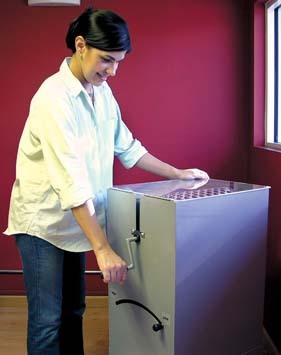Every morning, thousands of department store employees across the country spend up to 90 minutes doing some of the scut work of retailing – separating the two elements (the pins and gators) from the sensor-tagged anti-theft devices applied to apparel merchandise.
It's onerous, gobbles up time unproductively and can be dangerous – the pins are sharp!
The sensor tags have unquestionably helped prevent theft. But a different sort of problem for the retailer kicks in once all the sales clerks pull the two locked-together elements apart every time they make a sale and toss them into a box. Those boxes are dumped into a bin at night. In a good day, tens of thousands of pieces have been accumulated. And the next morning, the digging and sorting begins again.
“It was taking up too much of the employees' time every day,” says Noel Hernandez, director of store operations for the 77 Robinsons-May and Meier & Frank stores in six western states. “And we were seeing too many employees with bloody fingers.” Plus, it was keeping too many employees from the sales floor, impinging stores' productivity.
In other retail operations, the sorting was being done by sales associates, which also proved to be unproductive – it kept them from the sales floor serving customers and ringing up purchases.
So, as part of a larger initiative to find operating efficiencies, Hernandez began working with Customer Minded Associates (CMA, Miami), which helps develop backroom solutions and hanger-management systems for department stores and other retailers.
“This is what we do,” says Jeff LaPace, president of CMA. “We take customers' problems, of any type, and help come up with customized solutions.”
The solution, once they'd designed it, seemed remarkably obvious. A large metal bin is equipped with a basket full of holes. Each morning, the pins and tags are poured into the basket and an employee spins the basket around, like in a contest lottery. The size of the holes allows the pins to fall from the basket but traps the tags, sorting and separating the two elements in minutes.
But even then, there were kinks to work out.
“The concept worked from the beginning,” says Hernandez, “but it was supposed to be portable. The metal device we'd developed was much too heavy to move around as needed.”
The device was put on wheels, which increased its mobility – but too much. “It slid around the floor,” Hernandez says. “It was difficult to control.”
After CMA went back to the drawing board one more time and made the device with a light metal alloy – easy to lift and move from place to place – the lighter Spin-n-Sort became the heavy lifter in the back room of Hernandez's Robinsons-May and Meier & Frank stores in Arizona, California, Nevada, Oregon, Utah and Washington. It sorts approximately 250 tags and pins per minute.
“We sort the tags first thing each morning,” he says, “and that task of two employees taking an hour-and-a-half each is down to one employee sorting the tags in 10 to 15 minutes.” So it's 180 minutes versus 15 – you do the math.
Not only is the Spin-n-Sort a time-saver, the product effectively takes the handling of a sharp object out of the hands of employees to reduce on-the-job injuries and workers' comp claims and downtime. It also minimizes loose pins on the floor, which historically led to foot injuries.
“The product reduced non-productive hours for selling associates,” says CMA's LaPace. “In fact, sales actually increased because it freed up sales associates who otherwise might not have been available to service customers. And it put the tags back into use much more quickly, reducing their cycle time, which means less inventory is required at each store and at each register location. And, ironically, more sales associates and other employees easily visible on the sales floor inhibits casual shoplifting. So it reduces theft in a technical and non-technical way.”
Hernandez believes the labor-saving device did find its way into other May Co. divisions. And now that Federated owns all those stores?
“I imagine they'll keep the devices, and probably add them into their existing Macy's operations,” says Hernandez, who is already involved in the conversion of his 77 stores. “Why change a good thing?”


 Photo Gallery1 week ago
Photo Gallery1 week ago
 Headlines4 days ago
Headlines4 days ago
 Headlines1 week ago
Headlines1 week ago
 Headlines2 weeks ago
Headlines2 weeks ago
 Headlines1 week ago
Headlines1 week ago
 Designer Dozen1 week ago
Designer Dozen1 week ago
 Headlines1 week ago
Headlines1 week ago
 Headlines1 week ago
Headlines1 week ago







